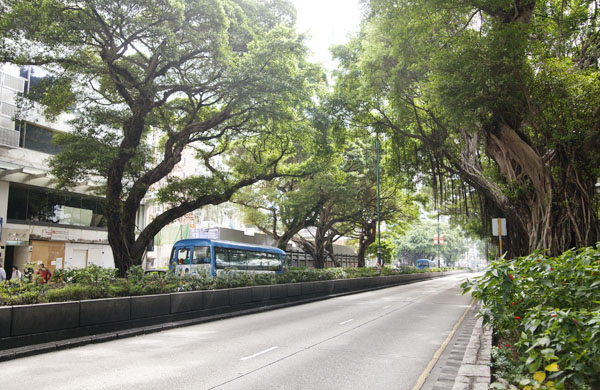
We started off 2013 in Hong Kong, where we attended a cousin’s wedding and hung out with lots of family. My husband’s parents are both from Hong Kong, and many of his relatives still live there, including both his grandmas. It’s a very nostalgic place for him and his brother, because although they were both born in the US, they lived there as small children for a little while. And since they continued to return frequently throughout their lives, they’ve accumulated a lot of memories there over time.
After we were married, I was lucky to get to join in these family reunions. We try to go back every couple of years, but when my husband’s generation was younger, they would actually have family reunions there every year!

For me, Hong Kong is both foreign and familiar because, while I am Cantonese, neither I nor my parents had ever been to Hong Kong (or China) until we were adults.
On the one hand, if you’ve been to Hong Kong, you know it is very culturally distinct. It’s an incredibly fast-paced, efficient, pressure-filled life. If you don’t have the right change getting onto the bus, you may very well be publicly reprimanded by the bus driver and shunned by the rest of the people behind you in line. People are always keeping up with the latest fashion, technology, even slang terms. I think I’m more of the French-influenced, people-watching, coffee-sipping, Vietnamese type who spend their idle hours contemplating life… or the next meal.

At the same time, although my family is from Vietnam, we’ve retained a lot of our Cantonese heritage. (I speak Cantonese at home, but my Vietnamese is pretty non-existent beyond pho, banh mi, and other necessities.) So to be in Hong Kong and understand everyone around me is quite a novelty. I do have some family ties there as well – my great-grandfather moved there late in life, and my father lived there part-time for a decade when he was studying for his doctorate. I also spent about a month in Hong Kong with my dad when I was a grad student and pretty much did every touristy thing there is to do in the city.

The place has really grown on me over time. One of the things that I find endearing about Hong Kong is the almost cartoon-like feel of the city. Amidst the hulking mountains, forest of concrete highrises, and people scrambling in their 2-hour-long commutes to work, you can actually find really cute, sometimes even comical things. Like the little red taxi cabs (Hong Kongers love bright colors) and green and yellow minibuses weaving through the narrow, hilly streets as if people were driving off to summer camp. And the double-decker buses that seem like they should be filled with tourists but are actually filled with commuters — some of whom may be eating gai dan zai (waffle-like egg balls that’s common street food there). I also love the enormous banyan trees that line the streets, their aerial roots like an old Hong Kong grandfather’s whiskers draping over people as they pass. It’s the perfect image of the city to me.

Above all, if anything makes me feel at home in Hong Kong, it’s definitely the food. I think Cantonese food is just as much a part of my childhood as Vietnamese. Until I visited Hong Kong, I didn’t realize that some of the dishes I grew up eating were in fact eaten somewhere other than our home. And as my visits to Hong Kong increased after getting married, my husband and I have developed a list of personal must-eats each time we go. Some of these are very particular to us. For example, we’re not huge dim sum people, so unless we’re going out with others, we don’t really have a hankering for dim sum (it’s something much better experienced in large groups anyhow). But anyone going to Hong Kong for the first time should definitely have dim sum.
Here are some of the things we do make sure to get when we’re in Hong Kong…
Custard tarts. Preferably of the flaky crust kind, which seemed to be less common this trip. Someone told me it’s because the shortbread crust is easier and less time-consuming to make. My husband and I unabashedly consume on average one per day in Hong Kong. For us, it’s like making sure to eat gelato every day in Italy. Little E had his first custard tart this trip and, much to our shock, did not like them. We tried over and over, even giving him just the custard part, but he would just spit it out. I’m not sure whose genes he got there!
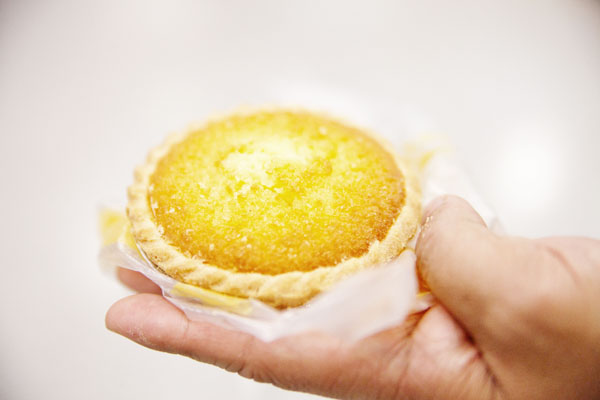
Coconut bun. A visit to a Hong Kong bakery is a must, and my other favorite thing to get there (besides custard tart) is the coconut bun or gai mei bao (this literally translates to “chicken butt bun,” and is also known alternatively in English as a “cocktail bun”), which is a long sweet, sesame-flecked bun filled with shredded coconut.
Toast with condensed milk. We’ve extolled the virtues of this delicacy here before, but let me just say this must be experienced in Hong Kong, where they serve it on extra thick pillowy bread. It’s usually available at a cha chaan teng (Hong Kong-style teahouse), as well as at the ubiquitous chain Cafe de Coral, which incidentally serves a decent version of most of the things on this list.

Wonton noodle soup. Good wontons, with properly cooked noodles, are tougher to find than you may think. I’ve been spoiled with my dad’s wonton noodle soup, and I’m sad to say that I’ve had many an inferior one, especially around Tsim Sha Tsui! More on Hong Kong wonton noodle soup in a separate post.
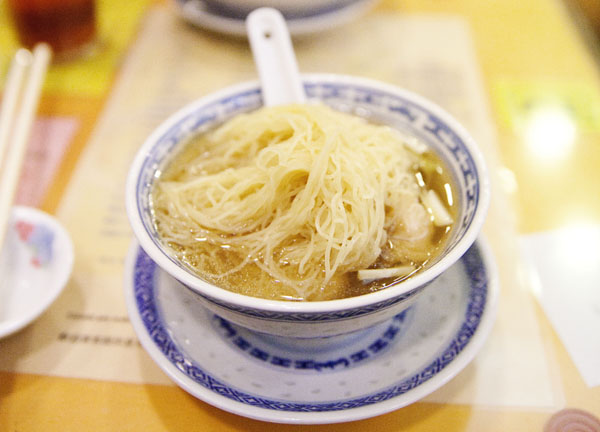
Fish ball noodle soup, with fish skin chips. There used to be a place on Cheung Chau island where my dad and I were regulars, and the lady knew our order as soon as we stepped foot in the door. But alas, they changed ownership, and it’s no longer what it used to be. But this dish is still commonly found around the city, and whenever I get it I make sure to also order some crispy fish skin chips. Some people like to dunk it into the soup, but I like it just as is.

Beef chow fun. These are wide rice noodles stir-fried with beef in a dark soy sauce. The good kind will have a nice charred taste from being stir-fried in a hot wok. We had a great one this trip that I’ll share more about later.
 Singaporean rice noodles. No Singaporean friend of mine will claim this dish, and true enough, it didn’t show up on a single menu when I visited Singapore. This is a purely Cantonese, Hong Kong thing. The dish is made of stir-fried vermicelli noodles with curry powder and soy sauce. For me, stir-fried rice noodle dishes are comfort food because my dad often made them at home, and this is one of my default meals in Hong Kong.
Singaporean rice noodles. No Singaporean friend of mine will claim this dish, and true enough, it didn’t show up on a single menu when I visited Singapore. This is a purely Cantonese, Hong Kong thing. The dish is made of stir-fried vermicelli noodles with curry powder and soy sauce. For me, stir-fried rice noodle dishes are comfort food because my dad often made them at home, and this is one of my default meals in Hong Kong.
Salt-and-pepper-fried anything. Oftentimes it’s salt and pepper prawns, squid, or crab. It’s so simple, but I just love the smoky flavor created by stir-frying basic salt and pepper. And then all the crispy garlic, onion, and leftover fried up bits that you can mix into your rice… that’s the best part.
Roast and cured meats. Roast meats, collectively known as siu mei, are what you commonly find hanging in the windows of Chinatowns around the world. The crispy roast pork is my favorite, but roast duck, goose, or barbecued cha siu pork are the other typical offerings. Yung Kee is particularly famous for its roast goose. But what I love even more than roast meat is cured meats, collectively known as lap mei. There’s the popular lap cheung (Chinese sausage), yeun cheung (duck liver sausage), and my favorite of all, lap ngap (cured duck). Usually these are sold dry at markets for preparation at home, but sometimes you can order them as a dish at a restaurant. You can also find cured meats in claypot rice…
Claypot rice. Also known as bo jai fan, this is rice slowly cooked in a clay pot over fire, so that the bottom becomes charred. My favorite topping to get is lap mei, which comes with Chinese sausages. The best part is the crispy layer of rice on the bottom. Some people like to add water to soften it up a bit, but I like it crunchy.

White-cut chicken. Although grouped in with other siu mei, or roasted meats, both white-cut chicken (which is poached) and soy-sauce chicken (boiled in a marinade) are the only meats not roasted. I do love my poached chicken, and my very favorite place to eat it is Hong Kong. When my dad lived in Hong Kong, he would come home raving about the chicken there and how it had so much more chicken taste! Indeed, I think a lot of chicken you get in Hong Kong seems to be more of the jow dei kind — that is, free-range, but it’s really more out of preference for their taste than ethical practices. The birds are scrawnier, with denser meat and, yes, have more chicken taste. During the month I spent in Hong Kong with my dad, sometimes we would just have white-cut chicken for days in a row. I am also a sucker for the ginger scallion dipping sauce and will also eat it mixed into my rice.
Mango desserts and drinks. There’s a specific place to get this, and that’s Hui Lau Shan, which has locations all over. I like to get the mango and coconut drink.
Food on a stick. This is especially popular around the Ladies’ Market in Mong Kok. I’m a fan of intestines, so that’s always my go-to. But you can also get less adventurous things, like fish balls.

Congee. Especially with pork offal! If that’s not your thing, pork and preserved egg is a classic. But if that’s not your thing either, there’s usually something more tame, like beef. And don’t forget the fried Chinese crullers to dunk into the congee.
Seafood. Whether it’s just simple clams in black bean sauce, salt and pepper stir-fried shrimp, or an elaborate seafood feast in Sai Kung (which I’ve never been to, but which my sister tells me is quite an experience), you’ll find a huge variety of super fresh seafood in Hong Kong. In Asia, fresh seafood means live seafood. At places like Sai Kung, you can pick your seafood from the local fishermen and then bring it to a restaurant to have them cook it up. There are also typhoon shelters that famously serve up crab, including this one where you can eat on the boat. That’s something we hope to try some day, but on this trip, it was a mini seafood fest on Cheung Chau island that I’ll share more about later.

Hong Kong “Western” food. After all those years of colonial rule, a certain type of “Western” food has developed in Hong Kong. Things like macaroni soup with ham, egg sandwiches with the crusts cut off, baked pork chop over rice covered in tomato sauce and cheese. Go to any cha chaan teng (Hong Kong-style teahouse) and you’ll see a huge variety of both Cantonese and Hong Kong-style Western food.
Milk tea. By which I do not mean the stuff with tapioca balls you drink with a straw. This is black tea with either condensed milk or evaporated milk, and it is known for being very smooth due to the traditional use of sackcloth bags to filter the tea leaves. You can also get it yeen yeung (“yin yang”), which is a combination of coffee and milk tea.
Wedding banquet food. A Hong Kong friend once told me that I should try to get invited to a Hong Kong wedding banquet because it is a cultural experience in itself. Well, that is just what happened on this trip. (My husband and I actually held a small wedding banquet here for family and friends shortly after we were married, but in typical wedding fashion, I barely remember any of it.) (Also, keep in mind, depending on how you feel about the ethical practices in procuring some of these ingredients, the Hong Kong wedding banquet experience may or may not sound that appealing to you.) There are a couple standard wedding courses, including the opening cold appetizer of roasted suckling pig. In the past, it was served with other cold meats, including strips of chewy jelly fish tossed in sesame oil and sesame seeds (this entire cold-cut platter might just be my favorite dish of the whole banquet). But apparently these days it’s popular to do just a simple roasted suckling pig for each table — and the servers all come marching in to music with a platter in hand. I’m told that sometimes the pigs even have flashing eyes! Just another comical Hong Kong moment. Other common wedding courses include crab claws and shark’s fin soup. This time, we also had swallows’ nest over vegetables.
I always forget how much I miss Cantonese food until I go to Hong Kong. You would think that living in Beijing now I would have much more access to these dishes, or that I’d be tired of Chinese food in general… But I very early on realized how drastically different northern Chinese food is from southern Chinese food. And I think when it comes to food you grew up with, it just never gets old.
Much more from our recent travels to come.

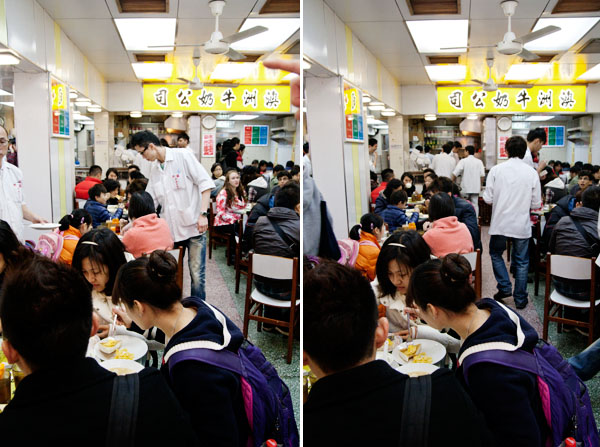 On our way out the door, I lingered a couple extra seconds to snap a few quick photos, panicking the whole time that someone would yell at me to get out of the way. When I stepped out the door, my husband asked me if I got some good shots, and I said, “No, I just took some quick ones ’cause I didn’t want them to yell at me.” He said, “What? You don’t have to leave until someone kicks you out! You should go back.” This coming from someone who snuck into the Hay Adams Hotel for “brunch” when Obama first arrived in DC for the inauguration in 2009. (He did get kicked out… but not before he’d done a few interviews.) I was still reluctant, but at his encouragement, I mustered up some pluck and marched back in there to document a bit of the action…
On our way out the door, I lingered a couple extra seconds to snap a few quick photos, panicking the whole time that someone would yell at me to get out of the way. When I stepped out the door, my husband asked me if I got some good shots, and I said, “No, I just took some quick ones ’cause I didn’t want them to yell at me.” He said, “What? You don’t have to leave until someone kicks you out! You should go back.” This coming from someone who snuck into the Hay Adams Hotel for “brunch” when Obama first arrived in DC for the inauguration in 2009. (He did get kicked out… but not before he’d done a few interviews.) I was still reluctant, but at his encouragement, I mustered up some pluck and marched back in there to document a bit of the action…


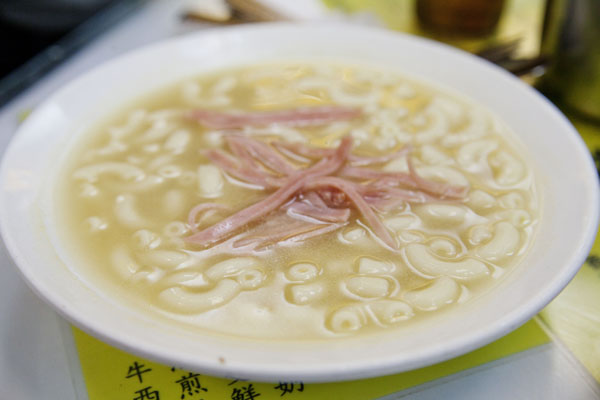
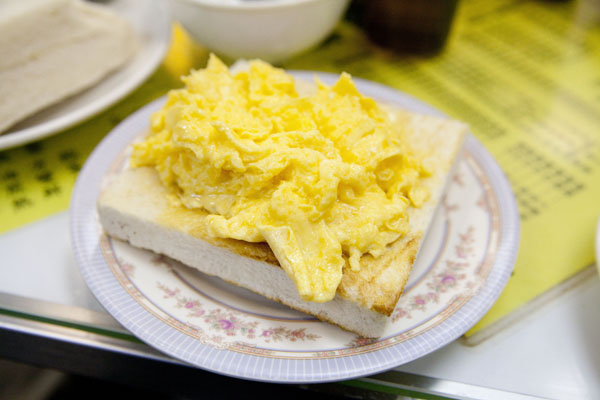






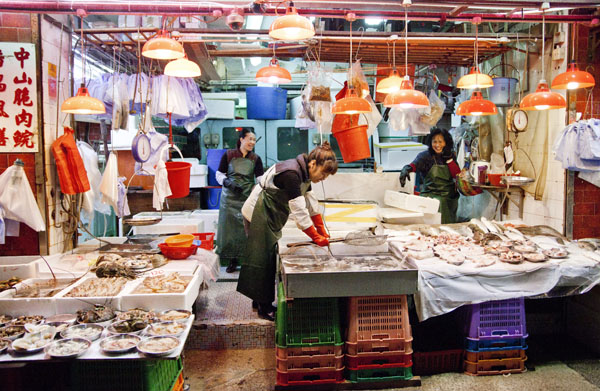






























Connect with us